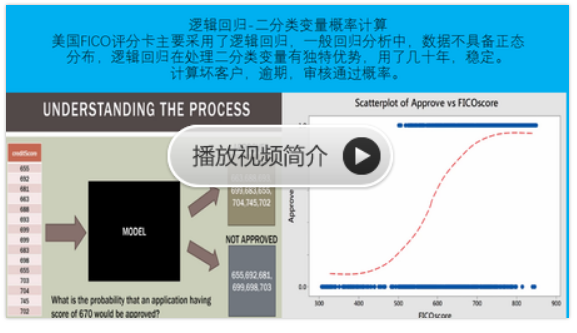python机器学习-乳腺癌细胞挖掘(博主亲自录制视频)
https://study.163.com/course/introduction.htm?courseId=1005269003&utm_campaign=commission&utm_source=cp-400000000398149&utm_medium=share
项目合作联系QQ:231469242
http://scikit-learn.org/stable/modules/sgd.html
Stochastic Gradient Descent (SGD) is a simple yet very efficient approach to discriminative learning of linear classifiers under convex loss functions such as (linear) Support Vector Machines and Logistic Regression. Even though SGD has been around in the machine learning community for a long time, it has received a considerable amount of attention just recently in the context of large-scale learning.
SGD has been successfully applied to large-scale and sparse machine learning problems often encountered in text classification and natural language processing. Given that the data is sparse, the classifiers in this module easily scale to problems with more than 10^5 training examples and more than 10^5 features.
The advantages of Stochastic Gradient Descent are:
- Efficiency.
- Ease of implementation (lots of opportunities for code tuning).
The disadvantages of Stochastic Gradient Descent include:
- SGD requires a number of hyperparameters such as the regularization parameter and the number of iterations.
- SGD is sensitive to feature scaling.
随机梯度下降(SGD)是一种简单但非常有效的方法,用于在线性分类器下的线性分类器的判别学习,如(线性)支持向量机和Logistic回归。虽然SGD长期以来一直在机器学习社区中出现,但最近在大规模学习的背景下它已经受到了相当多的关注。
SGD已成功应用于文本分类和自然语言处理中经常遇到的大规模稀疏机器学习问题。鉴于数据稀疏,此模块中的分类器很容易扩展到超过10 ^ 5个训练样例和超过10 ^ 5个特征的问题。
随机梯度下降的优点是:
效率。
易于实现(许多代码调优的机会)。
随机梯度下降的缺点包括:
SGD需要许多超参数,例如正则化参数和迭代次数。
SGD对功能扩展很敏感。
python脚本
from sklearn.linear_model import SGDClassifier X = [[0., 0.], [1., 1.]] y = [0, 1] clf = SGDClassifier(loss="hinge", penalty="l2") clf.fit(X, y)
梯度下降(GD)是最小化风险函数、损失函数的一种常用方法,随机梯度下降和批量梯度下降是两种迭代求解思路,下面从公式和实现的角度对两者进行分析,如有哪个方面写的不对,希望网友纠正。
下面的h(x)是要拟合的函数,J(theta)损失函数,theta是参数,要迭代求解的值,theta求解出来了那最终要拟合的函数h(theta)就出来了。其中m是训练集的记录条数,i是参数的个数。
![]()
![]()
1、批量梯度下降的求解思路如下:
(1)将J(theta)对theta求偏导,得到每个theta对应的的梯度
![]()
(2)由于是要最小化风险函数,所以按每个参数theta的梯度负方向,来更新每个theta
![]()
(3)从上面公式可以注意到,它得到的是一个全局最优解,但是每迭代一步,都要用到训练集所有的数据,如果m很大,那么可想而知这种方法的迭代速度!!所以,这就引入了另外一种方法,随机梯度下降。
2、随机梯度下降的求解思路如下:
(1)上面的风险函数可以写成如下这种形式,损失函数对应的是训练集中每个样本的粒度,而上面批量梯度下降对应的是所有的训练样本:

(2)每个样本的损失函数,对theta求偏导得到对应梯度,来更新theta
(3)随机梯度下降是通过每个样本来迭代更新一次,如果样本量很大的情况(例如几十万),那么可能只用其中几万条或者几千条的样本,就已经将theta迭代到最优解了,对比上面的批量梯度下降,迭代一次需要用到十几万训练样本,一次迭代不可能最优,如果迭代10次的话就需要遍历训练样本10次。但是,SGD伴随的一个问题是噪音较BGD要多,使得SGD并不是每次迭代都向着整体最优化方向。
3、对于上面的linear regression问题,与批量梯度下降对比,随机梯度下降求解的会是最优解吗?
(1)批量梯度下降---最小化所有训练样本的损失函数,使得最终求解的是全局的最优解,即求解的参数是使得风险函数最小。
(2)随机梯度下降---最小化每条样本的损失函数,虽然不是每次迭代得到的损失函数都向着全局最优方向, 但是大的整体的方向是向全局最优解的,最终的结果往往是在全局最优解附近。
4、梯度下降用来求最优解,哪些问题可以求得全局最优?哪些问题可能局部最优解?
对于上面的linear regression问题,最优化问题对theta的分布是unimodal,即从图形上面看只有一个peak,所以梯度下降最终求得的是全局最优解。然而对于multimodal的问题,因为存在多个peak值,很有可能梯度下降的最终结果是局部最优。
5、随机梯度和批量梯度的实现差别
以前一篇博文中NMF实现为例,列出两者的实现差别(注:其实对应Python的代码要直观的多,以后要练习多写python!)
// 随机梯度下降,更新参数
public void updatePQ_stochastic(double alpha, double beta) {
for (int i = 0; i < M; i++) {
ArrayList<Feature> Ri = this.dataset.getDataAt(i).getAllFeature();
for (Feature Rij : Ri) {
// eij=Rij.weight-PQ for updating P and Q
double PQ = 0;
for (int k = 0; k < K; k++) {
PQ += P[i][k] * Q[k][Rij.dim];
}
double eij = Rij.weight - PQ;
// update Pik and Qkj
for (int k = 0; k < K; k++) {
double oldPik = P[i][k];
P[i][k] += alpha
* (2 * eij * Q[k][Rij.dim] - beta * P[i][k]);
Q[k][Rij.dim] += alpha
* (2 * eij * oldPik - beta * Q[k][Rij.dim]);
}
}
}
}
// 批量梯度下降,更新参数
public void updatePQ_batch(double alpha, double beta) {
for (int i = 0; i < M; i++) {
ArrayList<Feature> Ri = this.dataset.getDataAt(i).getAllFeature();
for (Feature Rij : Ri) {
// Rij.error=Rij.weight-PQ for updating P and Q
double PQ = 0;
for (int k = 0; k < K; k++) {
PQ += P[i][k] * Q[k][Rij.dim];
}
Rij.error = Rij.weight - PQ;
}
}
for (int i = 0; i < M; i++) {
ArrayList<Feature> Ri = this.dataset.getDataAt(i).getAllFeature();
for (Feature Rij : Ri) {
for (int k = 0; k < K; k++) {
// 对参数更新的累积项
double eq_sum = 0;
double ep_sum = 0;
for (int ki = 0; ki < M; ki++) {// 固定k和j之后,对所有i项加和
ArrayList<Feature> tmp = this.dataset.getDataAt(i).getAllFeature();
for (Feature Rj : tmp) {
if (Rj.dim == Rij.dim)
ep_sum += P[ki][k] * Rj.error;
}
}
for (Feature Rj : Ri) {// 固定k和i之后,对多有j项加和
eq_sum += Rj.error * Q[k][Rj.dim];
}
// 对参数更新
P[i][k] += alpha * (2 * eq_sum - beta * P[i][k]);
Q[k][Rij.dim] += alpha * (2 * ep_sum - beta * Q[k][Rij.dim]);
}
}
}
}
转https://www.cnblogs.com/sirius-swu/p/6932583.html


